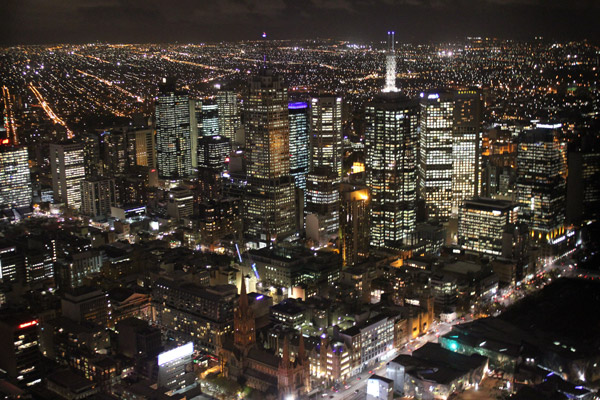Chris & Allyson vs. Australia (May 2012)
Day Twelve: Melbourne's street art. Cook's Cottage. The Old Treasury. Queen Victoria Market. Old Melbourne Gaol. Australian rules football. Goodbye to Australia.
In all forms of entertainment, you should try to go out on a high note. The human brain is a complex organ, capable of miraculous feats; but it is also easy to trick. The last memory of an event is often the deciding memory, so a big finish can overwrite the disappointments of the earlier stages.
As to why the amazing human brain is so easily duped? Our pathetic human brains haven't figured that out just yet.
When we woke up on our final day in Australia, the happy problem we faced was that our earlier notes were too damn high. Our expectations had already been surpassed. We didn't have the time or resources to do something mind-blowing, like a tandem skydive at sunset over Ayer's Rock with crocodiles for partners. But there was still the potential for a great day.
It was just a matter of deciding what kind of greatness we wanted. Allyson is more amenable to soaking in the culture of a city, whereas I favor a Bataan death march through as many historic sites as we can manage without causing an actionable divorce.
Whatever your preference, greatness begins with breakfast, according to several anthropomorphic cartoon animals that sell cereal. Our breakfast featured no cereal, but it involved a bit of Melbourne's culture. Laneways are narrow streets, often closed to car traffic and usually wedged in the middle of a city block. The ones downtown are stuffed with boutique shops and cafes. You can sit down at a table in the middle of the street, eat your bagel and watch the world go by. As I mentioned, I don't enjoy watching the world go by, as the world might be heading off to queue up at the museum I want to visit. Also, when you're a man in his 30s staring at strangers, you look less like a student of the human condition and more like a pervert. You have to be well into your 60s before that becomes socially acceptable.
But if your wife loves breakfast, you have to sacrifice every now and then, eat an egg sandwich and ogle some dirty backpackers. Once that was done, we deepened our appreciation of the dirty alleys of Melbourne by checking out some of the more artful graffiti. The less-trafficked laneways are tagged all over, sometimes to stunning effect; for example, we both enjoyed a 10-foot long diagram of a dog skeleton, completed in 2011. There were also fine examples of classic graffiti, in which people try to advance an incoherent world view by painting their political philosophy in a place where no one important will ever see it. If you find yourself in Melbourne, be sure to wander aimlessly through the dirty alleys. It's like stopping in a regional art museum, without having to pay admission, and only a marginal risk of getting stabbed.
Great wife that she is, Allyson yielded to my version of greatness for the rest of the morning. To that point, we had visited Melbourne while spending almost no daylight hours in the actual city. And as we all know, daylight hours are the best time to get out of the daylight and see the insides of important-looking buildings.

Melbourne street art!
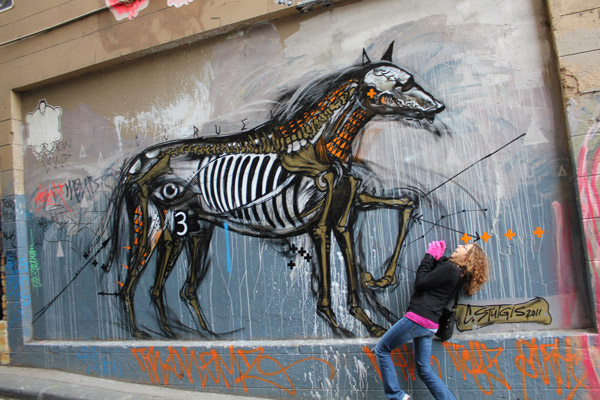
Beware of skeletal dog.
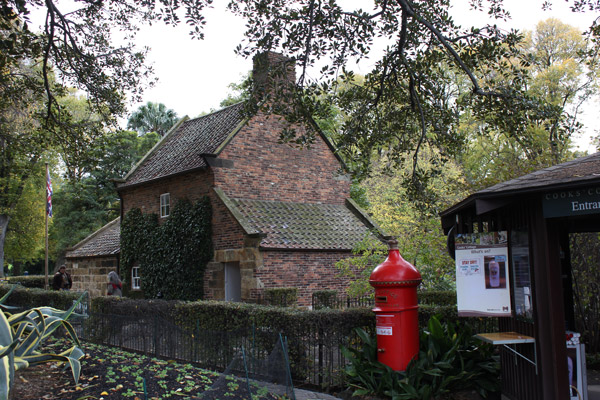
Cook's cottage in Fitzroy Gardens.
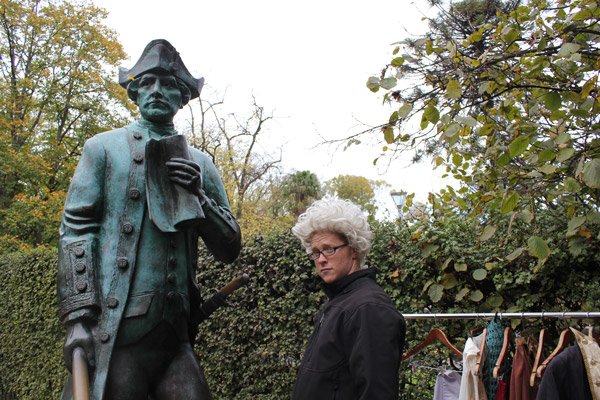
Wigging out at Cook's cottage.
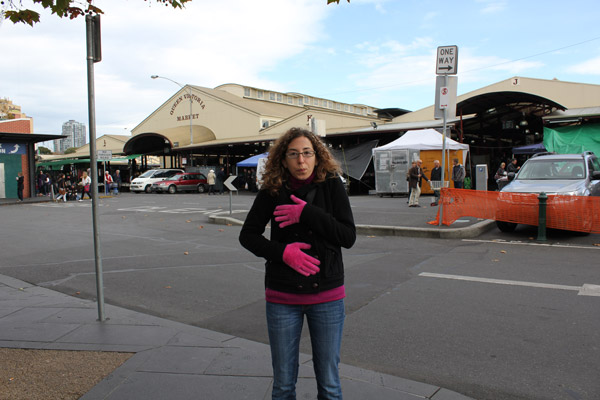
Ready to explore Queen Victoria Market.

Photographic evidence that Australia has fresh vegetables.
After a quick stop in St. Paul's cathedral -- surprise, it looks like a big church -- we made our way to East Melbourne and Fitzroy Gardens, a Victorian landscape dating back the 19th century. It was very important to me that we spend part of our last day in Melbourne seeing a structure that has nothing to do with Melbourne.
Around the time a teenaged James Cook was joining the Royal Navy in the 1750s, his parents built a small cottage in Great Ayton, England, no doubt using the move as a convenient excuse for throwing out all of their son's black light posters and bean bag chairs. James went on to some distinction, notably "discovering" and claiming Australia for the empire, then being smart enough to return home alive so that the claim might hold up. Cook probably visited his parents at their new cottage, and he might have crashed there on occasion. But it's a stretch to say he ever "lived" there.
Still, there's no point in letting a cottage go to waste, so when it was threatened with demolition in the 1930s, its owner sold it to an Australian businessman to keep it in the empire. It was taken apart, moved to Fitzroy Gardens and reassembled. Because people had a lower threshold for entertainment back then, it became one of the hottest tourist draws in town. The lines are a little shorter these days, but you can still tour it. And why wouldn't you? Someone was going to discover Australia eventually, but by claiming that honor, Cook established a chain of causality that leads to AC/DC. Without Cook's parents, no one records "For Those About to Rock," and then you have no song to put on the hi-fi when it's finally time to try for second base with your lady friend. That's something worth honoring.
They have a decent display on life in the cottage, and a room set up with an outline of Cook's achievements. Most important, they have a rack of period costumes that you can wear to pose for photographs, to finally determine if you look good in a giant white curly wig. I do.
But it's a short tour that doesn't quite qualify as great. So I dragged Allyson a few blocks to the Old Treasury, which actually has something to do with Melbourne. When the city was young, it was the place they kept all the gold; now it's a museum, with displays on the history of Victoria. The basement, where the gold used to be stored, is given over to some slick displays on the gold rush that made Melbourne into a real city.
But it's also a short tour that doesn't quite make it to great. So I dragged Allyson another block, to the Parliament House for Victoria Province -- another distinguished looking building that is clearly important, as it has a lot of columns.
We had missed the mid-day tour, but we had reached the point where taking Allyson to another museum would qualify as a hate crime. So it was time to let the pendulum swing back her way for a few hours, and the City Circle Tram was going to help us. The Circle is the tourist trolley: it runs in a loop around downtown and a recorded voice tells you about all of the delightful attractions you're not seeing by riding t//he tram. There are less smelly ways of getting around the city, but we hadn't taken a street car yet. And it's free, and it happens to run right past Parliament. About 15 magical minutes later, we were on the northern edge of downtown, within spitting distance of Queen Victoria Market.
The Queen Vic hails from a simpler time, before sushi was available in gas stations. In that time, getting fresh food to city dwellers was a serious logistical challenge, and cities the world over met it the only way they knew how: By throwing a lot of money at the problem. For example, Washington had a series of city markets where farmers could offload goods to urbanites.
But revolutions in refrigeration and distribution rendered most of them inefficient and obsolete. Only Eastern Market (est. 1873) stayed open, and it struggled for decades until enough white people happy to pay for overpriced cheese moved back to Capitol Hill. Now it serves less as a crucial delivery system for nutrition, and more as a place where people who are really worried about brunch can buy artisanal pickles so they have something to write about on their food blog.
The Queen Vic (est. 1878) is from the same era, and it has a similar story. All the other city markets in Melbourne shut down, but it survived a rough patch and emerged as a major destination -- not just for Melburnians, but for tourists who want to photograph huge piles of eggplants. It covers two city blocks, and even those of us who take no joy in the rhythms of everyday life have to appreciate the bustle.
There are flower stalls, chemists, delis, vegetable stands, cheese shops, fruit stands, cafes, wine shops and doughnut trucks. There's a Hall of Meat, a row of seafood stalls, a bratwurst stand and ice cream joints. If you aren't in the mood for edible things, there are dozens of vendors moving T-shirts, leather goods, souvenirs, sneakers, children's toys, lingerie, jewelry and home décor. Some of the merchandise and produce are very nice; some of it looks like it could be sold out of a trunk.
Even though it was the last day of our trip, it didn't seem realistic that five pounds of souvenir ox kidneys would stay fresh in our luggage for the flight home. But in the interest of making at least one major Queen Vic purchase, we popped into a shop that sold only Australian rules football gear. The wide selection of "dreadlock" hats was tempting, as I have often dreamed of looking like a stoned Predator. Bbut I settled on a knit cap with the Carlton FC logo -- it's Alan and Di's favorite team. And it stands to reason that if you wear an Australian rules football hat around America, the people who recognize it will either be Australian or relatively cool. It's like a divining rod for finding drinking buddies.
As utilitarian as it is, the Queen Vic actually works as a tourist attraction. Since we were half a world from home, some of the vegetables were practically exotic. To someone like Allyson, who loves vegetables almost as much as koalas and slightly more than freedom, it's like a plant zoo. That's not a perfect analogy, as most regular zoos don't have piles of dead specimens that you can eat, but it's close enough. There's also so much foot traffic that the people-watching is excellent.
But we're not foodies, and even the Hall of Meat loses its luster after a few minutes. Our day still wasn't quite great, and we only had a few hours left to make it so. We decided to go to jail.
More accurately, we went to gaol. The Old Melbourne Gaol opened for business in the 1840s, offering frontier justice at reasonable rates to the fine young men attracted by the gold rush. All you had to do was hit one Chinese laborer in the head with a shovel, and you got free room and board. It closed in the 1920s and eventually got taken over by a local school (with a brief return to prison duty for AWOL soldiers in World War II); in the 1970s, it was converted to a museum. You can walk there from the Queen Victoria Market in the time it takes to stab a man in the gut and steal his mule. From the outside, it looks like a prison: It's a squat, grey stone building that looks solid enough to prevent any hopes or dreams from escaping.
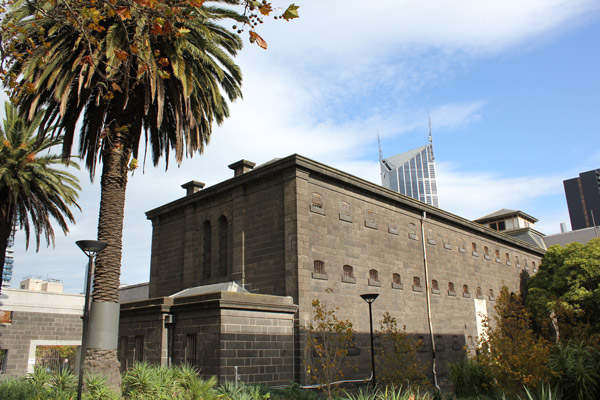
Rolling up on Old Melbourne Gaol.
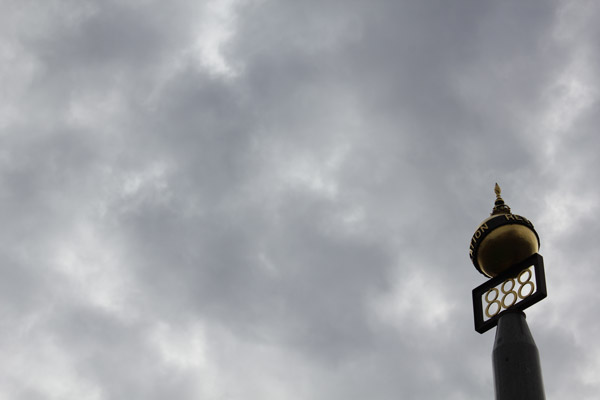
The eight-hour day monument in Melbourne.
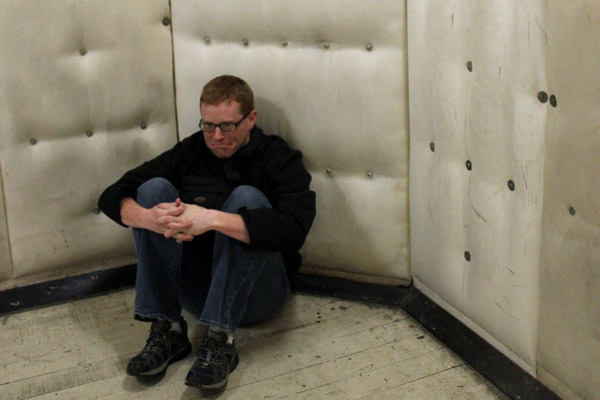
Padded walls are extra comfy. Old Melbourne Gaol.

New kid on the block. Old Melbourne Gaol.
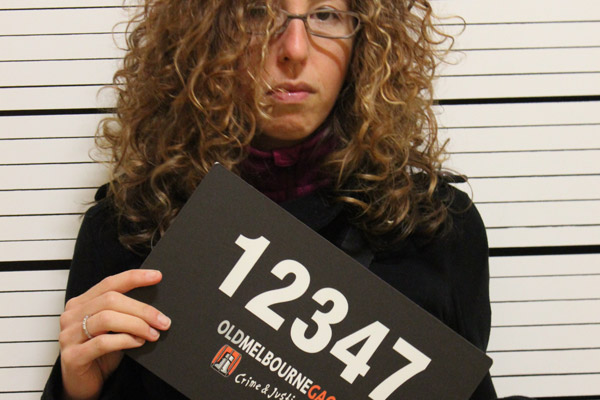
She fought the law and the law won.
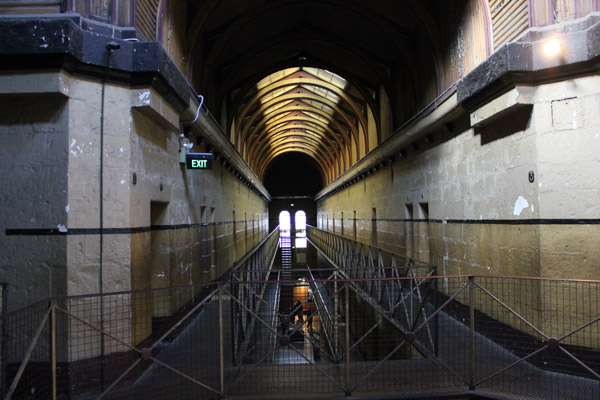
Ah, the understated beauty of a ... jail.
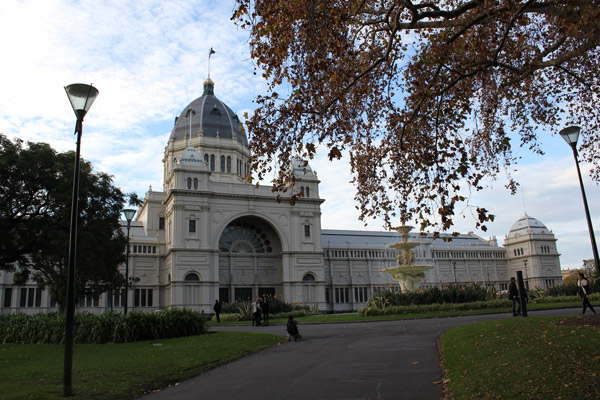
The Royal Exhibition Building.
If you're wondering what kind of ghoulish freak would want to visit a prison, I'd like to introduce you to my wife. Allyson is a woman who works very hard, but has little in the way of traditional hobbies; thanks to a bad back, she's limited in many physical pursuits, and thanks to a lifelong eye condition, she can't subject herself to extensive reading or computer work. But she has discovered a true passion for heinously violent crime. Mostly as an observer, I hope. She watches lots of television programs about women who murder their husbands, and she has enjoyed many audio books about serial killers. Sometimes, while enjoying these programs and audio books, she drifts off to sleep, and she sleeps quite peacefully.
So a prison accommodates both Allyson's fantasies of murdering me and my love of cold, lifeless buildings. And as an added bonus, the Old Melbourne Gaol has some legitimately cool history -- it's the place where Ned Kelly died. In Cairns, I had purchased a beer caddy inspired by his legend, and now it was time to learn something about the guy.
Ned Kelly is an Australian icon and, by most standards, a fairly hateful human being. All the evidence suggests that he came from a family of horse thieves, and at an appropriate age he joined the family business; after a few minor run-ins with the law, in 1878 Kelly and his gang kicked it up a notch by murdering a few police officers.
At that point, it gets to be a muddle. Kelly was of Irish descent, and some people of that persuasion think of him as a freedom fighter trying to flip off the Anglo-Australians who ruled Victoria province. More likely, he was dangerously psychotic and managed to convince himself that he was being noble by shooting cops. As Kelly and his gang were being hunted, they allegedly started to plan some kind of regional rebellion; it culminated in them taking an entire town hostage, with the hope of forcing an armed conflict with the police. When the authorities showed up, Kelly and his gang took them on in homemade armor, which was great for boosting confidence but only marginally good at stopping bullets.
The trial and execution were wrapped up within months, at which point the real legend of Ned Kelly began. He was enough of a polarizing figure that 26 years after his death, he became the subject of the world's first feature-length film, "The Story of the Kelly Gang." Decades later, he returned to the screen as portrayed by Mick Jagger, and by Heath Ledger a few decades after that. Ned has a sort of Che Guevara vibe about him, whereby people remember all of the philosophy that sounds great when you're baked in a college dorm at 3 a.m. on a Tuesday, while forgetting all of the things that made him a piece of human garbage.
There's also the matter of his skull. Ned's body was tossed in with the other riffraff in a mass grave, and with the changes to the building's functions over the years, those remains were shuffled around a bit. Ned's bones were finally found and identified in 2012, with the exception of his skull; his alleged brain casing had been on display in the gaol, but it was stolen in 1978. Nothing that has turned up since then has passed the genetic testing required to be the one true skull, so either it has crumbled to dust, or some Anglo-Australian millionaire is using it as a bowl for M&Ms.
For all of the drama, Kelly does leave an enduring legacy, however: beer caddy art. And also, if you go to the Old Melbourne Gaol, you can put on a plastic version of his body armor's helmet and prance around like you're the Black Knight in "Monty Python and the Holy Grail."
And yet, there's so much more to the gaol. It's a crime and punishment experience. Your tour starts in an old city watch house, which was operational into the 1990s. They process you. Me, Allyson, a dad and his two adolescent kids were lined up in a hallway, then given the "Scared Straight" treatment by an Officer Stark -- a pleasantly gruff semi-retired policeman. I took the "abject terror and total respect" approach, whereas the pre-teen boy in our group couldn't stop giggling. That got us tossed in a holding cell, at which point the officer cut the lights. Once we had observed the prison code and shanked that boy, we were all given a piece of stale bread and allowed to stretch our legs in the yard.
Legitimately, it is a lot of fun. The holding cells and the "yard" are the real deal, still covered with the graffiti and unscrubbable grime left behind by years of drunks and criminals. We sat in the one padded cell, took laps around the yard and posed for mugshots. Our entire experience was further enhanced by our fellow tourists, for as it turned out, the dad in our group was also a cop -- who had worked a stint in the city watch house. Once he tipped off Officer Stark, they just started trading stories about drugged-out wackos, criminals and frightened preppies that they had processed over the years. I'm guessing that the stories on the usual tour don't include many mentions of feces-throwing, so I feel like we were blessed.
Our new cop buddy had since switched to fighting child porn, and he was back in town to accept an award for hunting down one of the worst offenders in the history of Australia. His children were along to watch him receive the award, and he wanted to show them a chapter from an earlier part of his life. And the children seemed happy to be there, and to socialize with the stupid Americans. If you have the opportunity, I recommend taking any tour with a child-porn-fighting super cop. That memory will last a lifetime.
Once those pleasantries were done, we experienced the Old Gaol building at our leisure -- that's when we soaked in all the Ned Kelly lore, from the informational displays to the corner of the second floor where the gallows were. The have the individual cells decked out with the stories of other prisoners, and jailers, and executioners. There's actually something weirdly elegant about the building, which has a vaulted ceiling, metal catwalks and skylights letting in the sun. All things considered, it's a lovely prison experience.
And somewhere in the middle of that experience, our day became great. Maybe it happened when we were studying the clumps of dried toilet paper still stuck to the ceilings of the holding cells, or when we were pondering a chest filled with executioner's tools. There we were, enjoying both history and multiple homicides -- as a couple.
We put a little bit of a cherry on top of the sundae by taking a look at the outside of the Royal Exhibition Building a few blocks away, because it's a big pretty building -- the kind that you take pictures of, and 25 years later you stare at those pictures and wonder what the hell that building is. But after that, it was just a matter of taking a slow victory parade back to the hotel, where we might relax and celebrate our great day.
And, oh yeah, we had a great night coming. Thanks to the miracle of international friendship, we had tickets to see Australian rules football. When we determined that we'd be meeting Alan and Di, they asked what we might want to do. Our only request, coming straight from me, was for footie tickets. Melbourne is the pulsating heart of Australian sports, Victoria is the birthplace of footie, and you can't really experience the sport anywhere else in the world.
Plus, it's sexy. To Americans, Australian rules football is a vague international proxy for ridiculously violent athleticism -- basically, Rollerball. You don't spot it on American television systems all that much, so for all we know it's a bunch of men in bondage gear, riding kangaroos and hitting each other with boomerangs.
Alan soon let us know that we had only one option. On Saturday night, Collingwood was playing Geelong. And, oh yeah, it was a rematch of last year's championship game. And, oh yeah, it was at the Melbourne Cricket Ground, one of the most historic functioning stadiums in the world.
What can you do, right?
So let's get you up to speed on the most Australian of sports, a game that was originally designed to combine the elegance of soccer with the white-on-white violence of rugby.
The Rules of Australian Rules Football.
There are 18 men on a side. If this seems high to you, bear in mind that the field is an oval about 500 feet long and 425 feet wide, and no one is allowed to ride a horse.
The ball is shaped like an American football, but with less-pointy ends.
You can move the ball around the field in any direction however you like, short of throwing it. If you run, you have to "dribble" every now and then. A pass has to come in the form of a "handball" -- presenting the ball in front of your body, then pretending it is the head of the leader of whatever country is most opposed to Australia at that time, then punching it in the direction of a teammate. You can also kick the ball.
While you are holding the ball, opponents can do whatever they want to you, including tackling, punching, spitting, having a torrid and sensual affair with your wife or girlfriend, signing you up with any number of telemarketers, ruining your credit rating and eating your lunch out of the community refrigerator, even though you had clearly labeled the bag.
One of the few times a player cannot be molested is on a free kick. These are awarded after penalties. They are also awarded after you catch a ball kicked by a teammate, on the fly.
Each end of the playing field has four goal posts. The two in the middle are taller. You score a six-point goal by kicking the ball, on the fly, between the middle posts. You get one point if you run the ball between any set of posts, punch the ball between any set of posts, kick the ball between one of the outer sets of posts; or bounce a kick on the fly off of one of the central posts and over the goal line. If any opposing player touches a kicked ball in the air before it crosses the goal line, then that kick is worth only one point, even if it goes between the central posts. Does this sound complicated? Because it's actually a lot less difficult to explain than baseball, American football, cricket, basketball, rugby, and the very popular party game Cranium. Kicking ball through big posts -- very good. Every other way of getting the ball through any set of posts -- good, but a lot less good.
The game has four 20-minute quarters, with a halftime. There's also a stoppage time, kind of like soccer but more manly, at the end of each quarter.
The entire playing surface is bounded by a saltwater moat filled with crocodiles that must be at least 12 feet in length.
These rules were explained to us by Alan and Di, over a very nice Italian dinner at Southgate -- a fancy shopping complex across the Yarra and not too far from the Eureka Tower. They continued to explain them as we strolled along the river toward the Melbourne Cricket Ground. It's a nice walk, since that stretch of the south bank is the home to all of Melbourne's botanic gardens, and also a bunch of boat houses. I had jogged it earlier, while rowing teams were practicing on the river and early-morning bikers were zipping along the same footpath. The people of Melbourne are much fitter than you.
By the time we were approaching the stadium, more fans were walking with us, and we started getting the back story for the evening's match. Alan and Di were suffering on our behalf by going to see Collingwood play, because the Magpies are apparently the New York Yankees of the Australian Football League. Their colors are black and white, they spend money a lot more lavishly than the other teams, and their fans are jackholes. No one is indifferent about the team. Everyone who is not a Collingwood supporter hates them, wishes death upon their fans and would not be terribly upset if an asteroid hit their team bus.
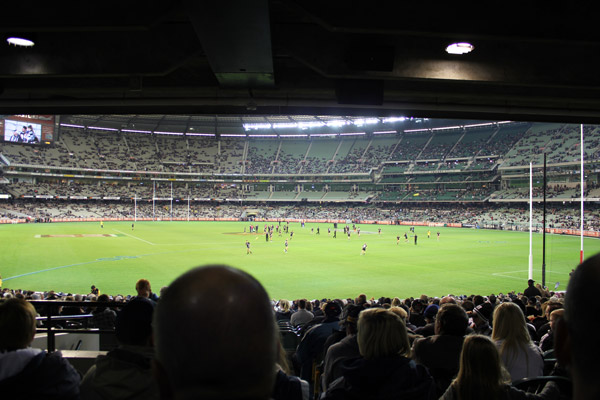
Collingwood vs. Geelong at the MCG.

Australian rules football, a truly awesome sport.
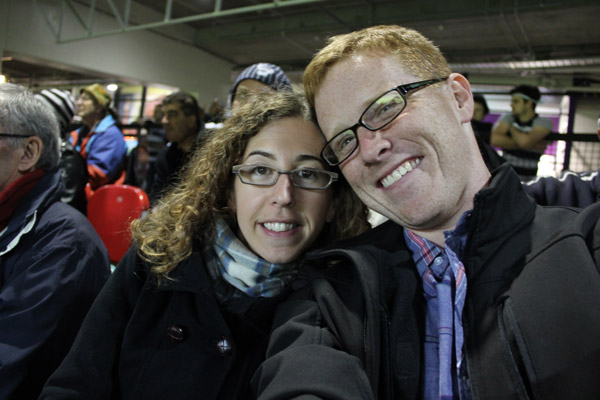
Sports!

The crowd filters out after a hard-fought match.
The Geelong Cats, the team that had won the championship in 2011, played in a far more elegant style, with lots of exciting ball movement and open-field running. Their colors are navy and white, and their greatest virtue is that they are not Collingwood.
But neither team was Carlton, the official AFL franchise of Alan and Dianne Hee. They are legitimate superfans; their house has many photos of them partying with AFL players. That they consented to take us to the game is further proof of their commitment to international relations.
As to the stadium: the Melbourne Cricket Ground is historic. The grandstands and facilities have changed over the years, but the playing field has been in use since the 1850s. It was one of the primary venues for the 1956 Olympics, and the annual grand final for the AFL has historically drawn some of the biggest crowds in the history of professional sports. It also has maybe the smallest nickname. Australians like abbreviating things when they can. For a while, it was the MCG; when that got to be too much of a hassle, they shortened it to "The G." In another decade, it will be known phonetically as "guh."
We got the full sporting experience. The stands were packed, and the crowd was into the game. Three guys from Adelaide had the seats in front of us, and once they picked up that we were AFL virgins, they also helped walk us through the action. I enjoyed the AFL version of the hot dog -- the meat pie. It became the most enduring souvenir of our vacation, as I am confident that my body will be unable to digest the whole thing if I live to be 135. We heard some of the finest, most impassioned cheering possible at a sporting event. Some of it haunts me to this day. We had an ardent Geelong supporter a few feet away, with a very high-pitched voice. He yelled a lot of great things, but when he was frustrated with a bad patch of play, he laid it out in plain English: "You're not being very Geelonglike, Geelong!" We chuckled about it, and then Alan added that the kid was exactly right.
And to be honest, the sport is kinda sorta awesome. Even Allyson, who has very little outward interest in these kinds of things, got caught up in the action. There's some specialization among players, but everyone has to be able to run soccer-like distances and beat the crap out of people, so most players are ridiculously conditioned, medium-sized wrecking balls. Most people can kick with either foot, while running, so they're all disturbingly coordinated. There's a tremendous advantage to catching a kicked ball to get a free kick, so every time the ball is in the air there's the potential for a contested, leaping grab. The strategy isn't tough to grasp -- if at all possible, you want to get a free kick within range of the goal. With that in mind, it's easy to see plays develop.
Best of all, we're talking about non-stop action in the style of a soccer match -- but unlike that inferior sport, the teams score constantly. Collingwood (lamentably) won, but the final was 96-84. The last two goals were scored in stoppage, after Geelong had a protracted stretch of Geelonglike play to come back and knot the game at 84.
When the game was done, we walked back to the hotel with Alan and Di, enjoying some people-watching along the way. A Nicki Minaj concert was letting out at a nearby arena at the same time as the game, and everyone around us was wearing either ill-fitting hot pants or a falling halter top. It was another remarkable display of athleticism, as teen skanks tried to prevent various things from popping out, all while walking in heels.
After we said goodbye and thank you to the Hees, we had one last culinary experience; we stopped at the French fry place that had been tempting us for the last few days. We went mainly because it was called "Lord of the Fries," and you have to reward that kind of ingenuity.
It wasn't easy to go to sleep, in part because I had just eaten a large number of French fries, and something that was politely described as gravy. But most of the unrest stemmed from the knowledge that our trip was done. Give or take 17 hours of plane travel.
Still, there were no regrets. In the quest for a big finish, we had soaked up Melbourne's food, culture and history. We had another meal with friends -- really, the only kind of meal you actually remember years later -- and we finished the day with 70,000 of our new friends in sport, watching a game you can't enjoy anywhere else in the world. That's how you vacation.
